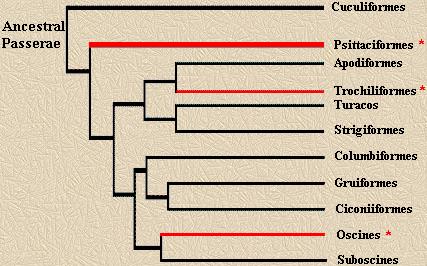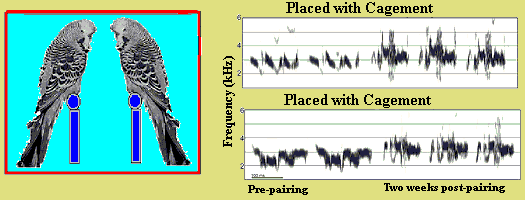
Laboratory of Steven E. Brauth and William S. Hall

Why Study Auditory-Vocal Learning?
Auditory-Vocal Learning is a fundamentally important learning process necessary for normal speech acqusition in humans. Auditory-vocal learning involves the ability to acquire communication sounds in a social context in reference to the communication sounds of external models. The term external models normally refers to members of the individual's species. In other words, species capable of auditory vocal learning are capable of imitating the sounds of other individuals or creating novel sounds shared with other individuals for the purposes of coordinating social or reproductive behavior.
Auditory-vocal learning is a comparatively rare ability among animal species. It did not evolve in primate species close to the hominid stem, but it did evolve in three orders of birds including the oscine songbirds, hummingbirds (trochiliformes) and parrots (psittaciformes) as shown below:

Our laboratory has focused on auditory-vocal learning in a small Australian parrot, the budgerigar (Melopsittacus undulatus) in an effort to understand the underlying neural mechanisms involved in auditory-vocal learning.
Why Study Parrots?
Most of what we know about vocal learning in birds is based on studies of the oscine songbirds. Vocal learning evolved independently in parrots and songbirds (see above). Therefore study of the neural bases of vocal learning in parrots can provide important comparison data useful in determining if common neural mechanisms exist for vocal learning, implying that optimal solutions exist for accomplishing vocal learning, or if different alternative solutions for accomplishing vocal learning have evolved in each taxa.
Why Study Budgerigars?
Both male and female budgerigars are capable of lifelong vocal learning. In budgerigars, vocal learning is based on social factors not on seasonal or hormonal factors. In these respects, vocal learning in budgerigars is similar to that of human speech acquisition, although budgerigar vocal communication does not involve generative grammar.
Contact Call Learning

Budgerigars can produce many different kinds of sounds including alarm calls, broad band sounds and, of course, budgerigars can imitate the sounds of other species including humans. Our laboratory has focused on contact call learning in budgerigars. Contact calls are short communication sounds produced by birds when they are in visible or audible contact. The figure above depicts sonograms of calls produced by two male budgerigars who were placed together for two weeks. The sonograms depict the distribution of energy in different frequency bands of the calls as a function of time. As can be seen, at the start of the experiment, each bird produced a different call. Within the two week time frame, the two birds came to produce a shared call as well as their prepairing calls. Budgerigars are capable of producing many different calls at any given time. Generally the call repertoires of males are larger than those of females, although both males and females continue to modify and alter their repertoires throughout adult life.
Research Questions:
Our laboratory has focused on the following research questions in studying the neural underpinnings of auditory-vocal learning in budgerigars: